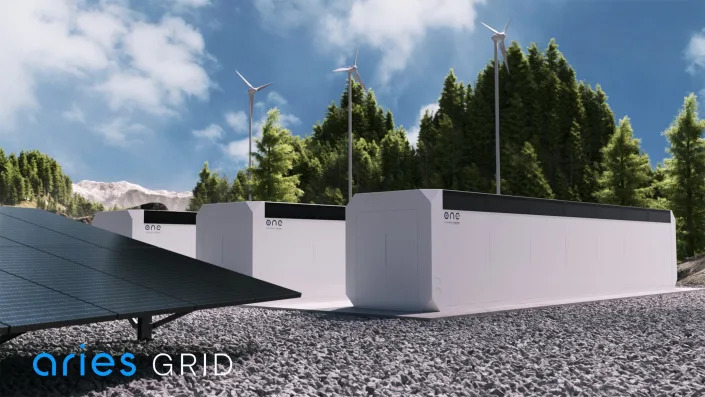Mark Phelan, Detroit Free Press
Sat, March 4, 2023
Batteries to make electricity from renewable "green" sources reliably available 24 hours a day will start rolling out of a Michigan factory in 2025. A smaller version of the batteries to power electric commercial vehicles goes into production in March.
Two utilities have committed to buying massive 6-megawatt-hours batteries, said Mujeeb Ijaz, CEO and founder of Our Next Energy (ONE). The size of shipping containers, the big utility batteries will store electricity generated from wind and solar sources.

Utilities can use batteries to store electricity from renewable sources, including wind and solar.
Currently, utilities sometimes shut down their renewable power plants because they produce more power than needed on particularly sunny or windy days. The batteries, which ONE calls Aries Grid, store the green power for later.
“There’s a lot of interest in the West,” Ijaz said. “States can’t use all the solar electricity they generate during the day. They shut off some capacity. Solar and wind power without batteries can be kind of a train wreck. Batteries even it out."
ONE will supply the batteries to a $500 million project in Ravenswood, West Virginia, to create a solar-powered manufacturing hub with Warren Buffett’s Berkshire Hathaway Energy Renewables. On the site of an old Kaiser Aluminum foundry, the plant will be able to generate 200 MW for industries on the 2,000-acre site.
BHE is the first customer for ONE’s Aries Grid utility storage batteries. ONE will produce the batteries at the site, using cells from the $1.6 billion Van Buren Twp. factory the company is building.
Mined and made in the U.S.A.
The batteries use materials that are widely available in the United States, particularly iron that’s largely extracted in the Great Lakes region, Ijaz said. The batteries are called lithium iron phosphate, or LFP.
LFP batteries cost less and last longer than the lithium-ion (Li-ion) batteries commonly used in electric vehicles and other products, Ijaz said. They’re also heavier and don’t hold as much energy, but ONE thinks it’s found a way around those limitations.

“We realized there was no major U.S.-based battery maker. We decided we should try to become that.” - Our Next Energy CEO and founder Mujeeb Ijaz
A Tesla S electric vehicle fitted with ONE’s batteries covered 752 miles at 55 mph in a range test last year, more than double the range of its factory-equipped lithium ion batteries. Ijaz said ONE’s battery, which combined two different sets of materials, was the same size and about 25% heavier than Li-ion. The extra weight isn’t ideal, but it's an acceptable tradeoff for the extra range. Like ONE, many companies are working to improve batteries' cost and improve their performance.
The S racked up more than 882 miles on a single charge in a later test on a dynamometer.
ONE’s EV batteries are scheduled to go into production for vehicles from EV makers Motiv and Bollinger this year. The company is building a big new factory that’s scheduled to open in Van Buren Township, west of Detroit, in 2024. Until it opens, Supplier Piston Automotive will build ONE’s batteries, also in Van Buren Township.

Our Next Energy has tested its long-range Gemini battery in a BMW SUV.
Ijaz, who had previously worked on battery and EV programs at Ford, A123 Systems and Apple, founded ONE in 2020.
“We realized there was no major U.S.-based battery maker,” Ijaz said. "We decided we should try to become that.”
EV battery improves range and recyclability
He set out to double the range of electric vehicles, but burgeoning use of renewable sources created an opening for utilities to use batteries so they could store excess power generated by sun and wind for use when those sources waned.
“Solar power plus batteries was not cost competitive in the past,” Ijaz said. “The Inflation Reduction Act leveled that out by incentivizing (battery) production and offering tax credits to utilities.” The act with clean energy goals was signed into law last year by President Joe Biden.

An electric vehicle skateboard using ONE's two-part Gemini battery.
ONE’s long-range EV batteries are actually two separate batteries. The company calls them Gemini. One section uses the same LFP materials as the utility and commercial vehicle batteries. It has a range of 150 miles and can be charged relatively quickly. The other part is based on manganese, another easily available material. It holds more energy to deliver a range of up to 450 miles, but takes longer to charge.
The two can combine to provide reliable power for up 50,000 miles a year over 10 years, Ijaz said, adding: ”That’s 500,000 miles. Well beyond warranty concerns.”
The LFP batteries have a 15-year life and are virtually 100% recyclable, Ijaz said.
Contact Mark Phelan: 313-222-6731 or mmphelan@freepress.com. Follow him on Twitter @mark_phelan. Read more on autos and sign up for our autos newsletter. Become a subscriber.
This article originally appeared on Detroit Free Press: Our Next Energy's LFP batteries store green power for later
No comments:
Post a Comment